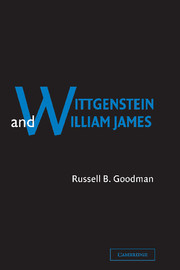Book contents
- Frontmatter
- Contents
- Preface
- Abbreviations
- Introduction
- 1 Varieties of Pragmatic Experience
- 2 Wittgenstein and The Varieties of Religious Experience
- 3 Wittgenstein and The Principles of Psychology: An Introduction
- 4 What Is It Like to Be a Human Being?
- 5 Language and Meaning
- 6 Pragmatism Reconsidered
- Coda
- Notes
- Index
2 - Wittgenstein and The Varieties of Religious Experience
Published online by Cambridge University Press: 23 July 2009
- Frontmatter
- Contents
- Preface
- Abbreviations
- Introduction
- 1 Varieties of Pragmatic Experience
- 2 Wittgenstein and The Varieties of Religious Experience
- 3 Wittgenstein and The Principles of Psychology: An Introduction
- 4 What Is It Like to Be a Human Being?
- 5 Language and Meaning
- 6 Pragmatism Reconsidered
- Coda
- Notes
- Index
Summary
“The outward face of nature need not alter, but the expressions of meaning in it alter”
(VRE, 424)“ … we may very likely find no one essence, but many characters which may alternately be equally important in religion”
(VRE, 32)After the publication of his Tractatus Logico-Philosophicus in 1921, Wittgenstein abandoned philosophy. He taught elementary school in a small village in Austria and helped design a house in Vienna for his sister, preserving the philosophical “silence” he thought appropriate both to ethics and to a work of philosophy offering “the final solution of the problems” (TLP, 5). By the mid-1920s, however, he was working on philosophy again, convinced that the Tractatus contained major mistakes. He returned to Cambridge in 1929, where he composed a paper on logical form that he soon repudiated, and, toward year's end, a “Lecture on Ethics.”
In that first year back in Cambridge, Wittgenstein met a young student of philosophy, Maurice O'Connor Drury, who was to become a lifelong friend. Drury was one of those serious, unpretentious people whom Wittgenstein tolerated, sought out, and opened up to. Originally planning on the priesthood, Drury became a physician and a psychiatrist at St. Patrick's Hospital in Dublin. It was to Drury's flat in Dublin that Wittgenstein came when he left Austria in 1938; and again in 1948 after he resigned his Cambridge professorship. Drury was with Wittgenstein when he died in 1951.
- Type
- Chapter
- Information
- Wittgenstein and William James , pp. 36 - 59Publisher: Cambridge University PressPrint publication year: 2002



